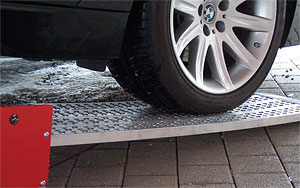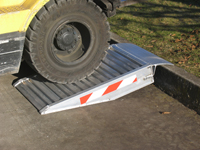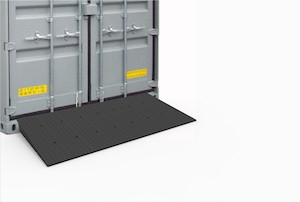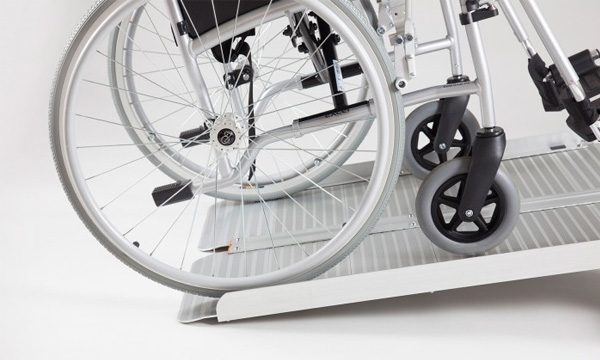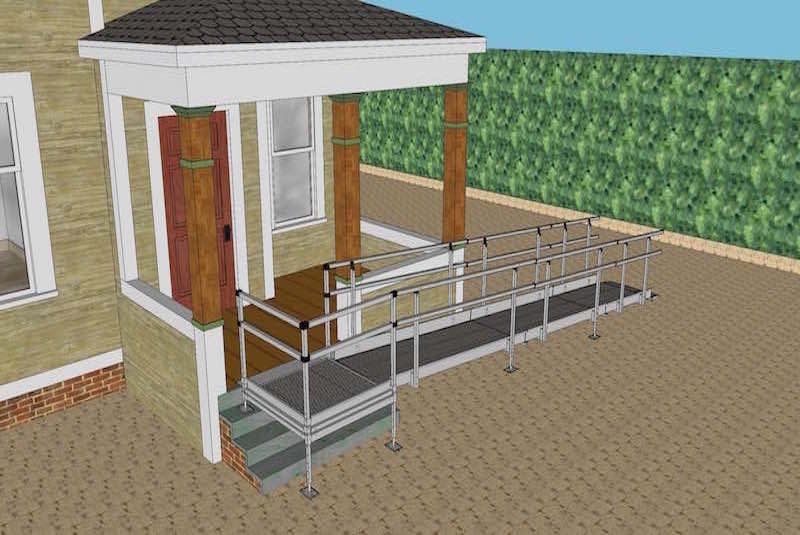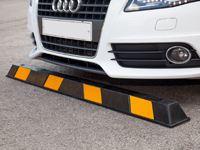FAQ's
Car Ramps FAQs
Are prices/capacities listed for a single ramp?
All prices/capacities listed on our site are for a pair of ramps unless otherwise specified.
How long do my ramps need to be?
The vertical height you are loading up will dictate the length of ramp required, if your car has low ground clearance you will also need to take this into consideration.
How steep should my ramps be?
It entirely depends on the vehicles being loaded, a sports car will require a much gentler gradient than a 4x4, if you are unsure please contact us and we will be able to assist.
How do I know the capacity I require on a ramp?
When selecting a ramp capacity check the weight of the vehicle, add around 150kg-200kg to allow an extra weight for fuel, operator and any other load added to the vehicle weight. That will be the capacity you will need the ramp to take.
Should I allow extra capacity in the ramps for safety?
No, this is not required. Our ramps are manufactured and engineered in the EU to European TUV standards, which require us to build in a 200% safety breaking point margin. Although the ramps are tested and built on a 200% safety, please note, if the ramp is overload this will void warranty.
How do I secure the ramps safely?
There are 4 types of connection for our loading ramps suitable for different vehicles & applications. Rest on connection with a drilled hole for the safety pin tends to be the standard as they work in most situations. For our car ramps we would recommend either the rest on connection with a drilled hole for the safety pin or the hook connection. The rest on connection is the standard as they work in most situations. Our connection options can be viewed here.
Do I need to consider the ground clearance of my vehicle?
Most of our loading ramps are built for maximum 30% gradient. Vehicles that are low or long might ground out with this gradient, we recommend a lower gradient, which varies from vehicle to vehicle. Please contact us before ordering so we can offer the best help from our expert team.
View our wide range of Car Ramps here.
Plant Ramps FAQs
How long should the ramp be?
For health & safety reasons, we recommend our plant ramps are not used with a gradient greater than 30% (16.5 degrees). Furthermore, no TUV Certified Ramp is designed to exceed this gradient. To calculate your gradient simply measure the height from ground level to the loading deck & multiply this by 3.3 to give the optimum length of ramp.

Do the ramps have a minimum load height?
Yes, the minimum load heights are noted on our website. We do not recommend using the ramps below the miniumum load height as the ramp will not sit flush with the floor. This in turn will affect the capacity the ramp can hold and void the warrenty if you are loading at the incorrect height.
We can custom cut your ramps for your load height. For custom solutions, please contact our ramp specialists.
Can the ramps be used over the max load height?
No, the ramp will be too steep. Using the ramp above it’s recommended load height may cause accident, injury or death and will invalidate the warranty. The ramps will also not sit flush to the floor which will impact the capacity the ramp can hold and void the warranty.
Should I allow extra capacity in the ramps for safety?
Our ramps that are included in our Vehicle And Plant Ramps section and in our Viper - Premium Heavy Duty Van Ramps sections on our website are manufactured and engineered to European TUV standards. These have been designed, built and tested in accordance with the following technical standards applied by the manufacturer: EN 1090-3, EN 1999-1-1, EN ISO 15613, EN ISO 15614-2, EN 1398:2009.
How do I check the wheelbase measurement on a tracked machine?
Look at the vehicle from side view, the distance between the centre of front wheel and rear wheel (rim centre) is your wheelbase.
If loading a machine with unbalanced weight distribution (where more of the weight is over one axel), how do I check the capacity the ramps can take will be suitable?
For machines with an unbalanced weight distribution such as, scissors lifts, paving machinery, steel tracked machinery and machines with low ground clearance we would advise you contact us first, so we can check and advise on the most suitable solution.
How durable are aluminium ramps compared to steel?
If the ramps are used sensibly, there is no reason why aluminium ramps should not last as long as steel, and much longer than steel ramps with wooden inserts.
Can I load steel tracked equipment?
The Ramp People have a number of vehicle ramps and plant ramps that are available with a rubber coated surface or milled surface that allows the harder steel tracks to be used on aluminium ramps. The usual vehicle and plant ramps are NOT suitable for solid wheeled machinery.
What is the minimum track width?
The narrowest the tyre/track of the vehicle can be on the surface of the ramp. This is to make sure the weight is spread across the surface to improve the life expectancy of the ramp.
When in use, how do I secure the ramps to my vehicle?
Safety is the primary concern and The Ramp People can provide a number of very secure connection options to suit your vehicle and it is really up to you which one you prefer. Many of our ramps are supplied with our movable connection plates that slide in the aluminium extrusion under the loading lip. This device should be placed between the lorry bed and the tailgate. Once this is in place the ramps will not shift during loading. Another option is to use the drop bolts supplied. The loading lips/rest on connections of the ramps are pre-drilled to accommodate the bolts. Our low loader ramps have underside tie bars for attaching a chain or strap. Our connection options can be viewed here. The standard connection provided is a rest on connection and for alternative connection types the fee is £100.00 + VAT.
Do the ramps have Safety edges?
All products are built flat top/no edges unless specified that edges are required. Products built with edges are production orders and therefore a longer lead time. The edges also decrease the usable width.
What if I need a specific length or width?
The Ramp People can manufacture vehicle ramps to specific needs, please contact a sales advisor for a quotation.
Can The Ramp People manufacture special applications/do custom builds?
The Ramp People manufacture a wide range of aluminium and steel extrusions and have been able to solve many unusual loading problems. Previous projects include purpose made plant ramps for drilling rigs, custom built truck ramps, ramps for unloading barges, vehicle ramps for the MOD and the oil industry along with many specialist plant ramps and car ramps. We can also manufacture bespoke ramps for wheelchairs and disabled access. Modifications undertaken by anyone other than The Ramp People invalidate the warranty.
Can I load a forklift on a plant ramp?
Not without first double checking with an advisor before purchasing. Forklifts are not designed to operate on inclines which means they need a very long ramp. They also have solid wheels which can damage the ramp surface so often we have to supply a reinforced model from our factory.
Can I use a winch to assist loading equipment?
Winches fundamentally alter the normal weight distribution when loading machines and equipment. Stated weight limits are dramatically reduced when using a winch. Winches can be used but great care and attention must be taken, please speak with our sales advisers for help specifying ramps. The most important thing is to keep the rope of winch parallel with the ramp. If you intend to use a winch please make this clear to your sales adviser before purchasing.
Product Dimensions – please note that due to manufacturing techniques and processes all dimensions of products may vary by up to 2% plus or minus of the dimensions shown on the website. The only exception to this is ramp length of our vehicle ramps and loading ramp range – the lengths shown may vary by up to 5% depending upon the connection chosen. If you require a specific length please do let us know and we can advise accordingly.
The ramp I require shows as 'Built to Order', how long is the lead time?
Generally the lead time for built to order loading ramps is 3-4 weeks (please note, during the summer months this can be longer due to factory closures). Please contact our team for an up to date lead time, they also will check to see if we have any alternative suitable ramps in stock for immediate dispatch if you require these sooner.
Truck and Van Ramps FAQs
How long should the ramp be?
For Truck & Van Ramps Health & Safety recommend that a gradient no greater than 30% (16.5 degrees) should be used. Furthermore, no TUV Certified Ramp is designed to exceed this gradient. To calculate your gradient simply multiply the bed height of your vehicle by 3.3 to give the optimum length. If loading long/heavy cases or pallet trucks, we recommend much longer.

Do the ramps have a minimum load height?
The minimum and maximum load heights will be stated on the product page. If no minimum load height is stated, we don’t advise to use the ramps lower than 100mm of the stated max load height as the foot end will not sit flat on the ground. For example, if the ramp has a max load height of 900mm do not use lower than 800mm.
For custom solutions, please contact our ramp specialists.
Can the ramps be used over the max load height?
No as the ramp will be too steep. Using the ramp above it’s recommended load height may cause accident, injury or death and will invalidate the warranty.
Should I allow extra capacity in the ramps for safety?
No. Our ramps are manufacturer and engineered to European TUV standards, which require us to build in a 200% safety margin. Please note, if ramp is overloaded this will void warranty.
Can I use a winch to assist loading equipment?
Winches fundamentally alter the normal weight distribution when loading machines and equipment. Stated weight limits are dramatically reduced when using a winch. Winches can be used but great care and attention must be taken, please speak with our sales advisers for help specifying ramps. The most important thing is to keep the rope of winch parallel with the ramp. If you intend to use a winch please make this clear to your sales adviser before purchasing.
How does the ramp connect to the vehicle?
All of our portable truck & van ramps use a rest on connection which rests onto the floor of the vehicle. The Premium van ramps & the truck ramp range come supplied with a locating pin which can be used to anchor the ramp if a matching hole can be driven into the floor of the vehicle.
How grippy is the surface?
As grippy as we can make it without causing damage to tyres or excessive wear to the surface. Our ranges have light serrations cut across the width which is suitable for dry, clean conditions. If you plan to use in wet or muddy conditions further grip might need to be added such as griptape or rubber covering.
Can the ramps be customised?
We can customise the ramps to your required length and width, we also have alternative connection types available and can build the ramps for various capacities. The lead time on built to order items is normally 3-4 weeks.
What is the difference between the premium van ramps and the economy ramps?
Our premium ramps are TUV certified and produced in Italy which means they can be customised if required. The entry onto the ramp for the premium version is slightly smoother than the economy version. In addition to this, the premium version holds a higher capacity (1,000kg+) than the economy version.
Fixed Folding Van Ramps FAQs
How do I find the correct size of ramp for my van?
With so many models and variations we ask that you complete our measurements document so that we can recommend the best suited model for your application. It is imperative to check these measurements as the wrong size of ramp will not fit the van. See here our measurements guide which we ask you to complete and return via email.
What are the benefits of the mesh surface?
The mesh surface is slightly lighter, has an improved grip, and in wet conditions it allows water to run through the surface rather than down it. The mesh also leaves some visibility through rear windows.
What is the pivoting/twisty System?
The pivoting system is a hinge on the bottom corner of the ramp which allows the system to be turned 90 degrees in or out of the van making for quick access the loading bay without the need to deploy the full ramp.
Can I install the ramp myself?
Yes, our ramps can be fitted by any competent DIYer see our fitting guide here.
Can the ramps be easily removed?
As standard, it will mean removing bolts and brackets which could take some time. If the ramp is to be regularly removed then we suggest you purchase our quick release system which allows the base plate to be unclipped in under a minute leaving just the brackets on the floor. The quick release system is NOT available for ramps with the twisty system.
Can the ramps be secured when vehicle is moving?
Yes, we will supply a pair of straps to secure the ramp for when the vehicle is in movement. Please note, not using the straps will decrease the life usage of the ramp, cause damages and will void the factory warranty.
Can the ramp be customised if I need a specific length, width or capacity?
The Ramp People can manufacture folding van ramps to specific needs, please contact a sales advisor for more information.
What if I need spare parts?
The Ramp People keep various spare parts in stock for a next day delivery.
Are the folding van ramps suitable for loading wheelchairs?
Yes, they are suitable however we recommend the mesh surface ramps for loading wheelchairs.
Are these kept in stock?
We have a variety of folding van ramps held in stock for immediate dispatch, our most popular and in stock ramps can be viewed here.
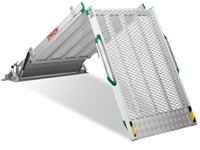
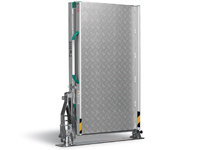
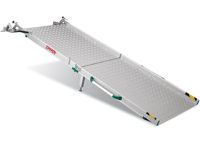
Motorcycle and Folding Loading Ramps FAQs
How do the ramps connect to the vehicle?
The ramps use a rest on connection which is either red prongs or a solid lip (depending on model) which rests onto the surface you are loading onto. Straps come supplied which can be used to secure the ramps in place.
Are they lightweight?
Yes, all our folding ramps are under 20kg in weight per pair. A pair splits up the weight so that you only need to move one ramp at a time.
Can I buy a single ramp?
Yes, singles can be viewed under motorcycle ramps on our website.
How grippy is the surface?
As grippy as we can make it without causing damage to tyres or excessive wear to the surface. We have a variety of surfaces available, including a mesh surface and cut-out grip system to allow you to choose a suitable surface for your requirements. If you plan to use in very wet or muddy conditions further grip might need to be added such as griptape or rubber covering.
Which length ramp should I buy?
You need to check your load height (from the ground to where the ramp will rest) as this affects the length of ramp required. All of our products note the maximum load height for the ramp in question. You also need to consider the maximum weight you wish to load.
How wide are the motorcycle ramps?
We have various widths available from 230mm - 440mm.
Why are the ramps curved?
The ramps are curved to improve ground clearence.
What other items can be loaded on these ramps?
Our motorcycle ramps are regularly used to load quad bikes, ride on lawnmowers, garden machinery and ATVS.

Cable Protectors FAQs
Why are there so many different types?
We offer a complete range of cable protectors from pedestrian covers to heavy duty vehicle hose ramps so that we are ready to assist with any application. We also provide kerb ramps with channels underneath so cables can run below them.
What is the difference between a cable cover & a cable protector?
A cable cover is designed to drop over wires whereas cable protectors encase cables completely. Cable covers offer a swift installation/removal. Cable protectors offer a more secure protection.
Do you have cable protectors suitable for vehicles to cross?
Yes, we have options with capacities ranging from 2000kg to 15,000kg (per section) but please be aware as our 2-channel option is 105mm high it is only suitable for HGV’s & other vehicles with plenty of ground clearance.
How can I check the channel size?
All channel dimensions are listed in our product specification pages, if you are at all unsure or cannot find a suitable option please get in touch.
What are they made of?
The majority of our range is rubber although there are some polyurethane options. This means our products are heavy duty and hard wearing.
Can they be fixed in place?
We do not recommend fixing our products as they are designed to be portable. Some customers have used adhesive tapes or fixings but the product does not come supplied with fixing holes or fixings.
Can cable protectors be used in a warehouse?
Yes however please ensure you select one of our cable protectors that are suitable to be used with forklift/trollies, for example within the Adam Hall range there are cable protectors which are suitable for items with low ground clearence.
Can wheelchairs go over cable protectors/cable covers?
We have a range of cable protectors which are suitable for wheelchairs, these can be viewed here.
Can cable protectors be connected together?
Yes, our heavy duty cable protectors and cable covers are interlocking so you can create your required length. Our rubber cable protectors are available in lengths up to 9m, as they are rubber you can cut these to your required size when needed.
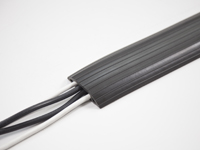
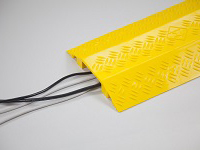
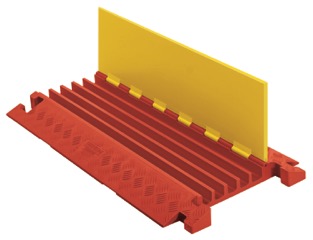
Pallet Truck Ramps FAQs
Why are they so long for such low heights?
Pallet trucks are not designed to operate on slopes due to a long low wheelbase. Because of this a very gentle gradient is required especially when moving heavy weights.
Can they be used on steps?
Yes, our pallet truck ramps can be used in other areas where low obstacles need to be overcome.
Should I allow extra capacity in the ramps for safety?
No. Our ramps are manufacturer and engineered to European TUV standards, which require us to build in a 200% safety margin.
Can I use a winch to assist loading equipment?
Winches fundamentally alter the normal weight distribution when loading machines and equipment. Stated weight limits are dramatically reduced when using a winch. Winches can be used but great care and attention must be taken, please speak with our sales advisers for help specifying ramps. The most important thing is to keep the rope of the winch parallel with the ramp. If you intend to use a winch please make this clear to your sales adviser before purchasing.
How does the ramp connect to the container?
All of our container ramps use a rest on connection which rests onto the floor of the container. We do have alternative connection types available which can be viewed here. There will be an additional fee of £100.00 + VAT for the alternative connection.
How grippy is the surface?
As grippy as we can make it without causing damage to tyres or excessive wear to the surface. Our pallet truck ramps have light serrations cut across the width which is suitable for dry, clean conditions. If you plan to use in wet or muddy conditions further grip might need to be added such as grip tape or rubber covering.
What if I need a specific length or width?
The Ramp People can manufacture to almost any width or length required.
Can you use all kind of pallet trucks or forklifts on the pallet truck ramps?
No. Most pallet trucks and forklifts are not built to be used on slopes or at an incline. Therefore you can use only the smoothest gradient. Please check the manual of the manufacturer for the gradient information.

Rubber Threshold Ramp FAQs
What is a threshold ramp?
Threshold ramps are provided as simple ramp solutions to allow the user to navigate through doorways, over curbs and other low heights. They are provided at a safe gradient to allow manual and electric wheelchairs to go up the threshold.
What height variations are there?
We supply from 4mm to 7inches/177mm high in our rubber range with many sizes in between suitable for almost any doorway or step.
How do you measure the height of wheelchair ramp you need?
Simply use a tape measure to identify the total vertical height of the threshold and select the ramp which is closest to this height.
What is the difference between the metric and imperial ranges?
The metric are designed for lower heights & have a 1:10 gradient ratio. The imperial are slightly steeper, higher & some have sloped edges.
What widths are available?
The metric options up tp 70mm are 1000mm wide whereas the others vary. Please check the product page for specific widths as some of the higher heights must be purchased in pairs to be suitable for wheelchair use.
How to clean these ramps
Only washing up liquid well diluted with water should be used. Rubber is a natural product and chemicals should not be used to ensure there is no reaction.
Do they smell?
The natural smell of rubber is fades after a couple of days in fresh air. To assist the process wiping the surface with a damp cloth with washing up liquid on.
How portable are they?
Being solid rubber they are quite heavy so should ideally be left in place semi-permanently. The weight helps to keep them in place.They are waterproof so you can leave these outside.
Are they suitable for electric wheelchairs and mobility scooters?
Yes they are due to a gentle gradient.
Can they be customised?
No, but they can be easily cut at home using a saw or knife. Please only cut these widthways so you do not affect the gradient of the ramp.
How can I purchase the rubber threshold ramp VAT exempt?
Yes, all of our wheelchair ramps can be purchased VAT exempt. VAT exemption is available if you are disabled or you are purchasing on behalf of someone on is disabled, for example a friend or family member. Charities can also purchase VAT exempt. At the checkout stage there is a VAT exemption box, we simply require the name of the person the ramp is for and disability. If this is for a charity, please provide the charity name and charity number.

Channel Ramp FAQs
What advantages and disadvantages does a pair of ramps have?
They are much lighter to lift as only one needs to be picked up at a time but the width does need to be set for each wheelchair wheel.
Are they suitable for electric wheelchairs and mobility scooters?
Most of them are not, due to the high upstand safety edges these are not suitable for electric wheelchairs or mobility scooters. However, this range is suitable as they have low profile edges.
Are they easy to store?
As the ramps are telescopic they can go to a very compact size for storage.
What lengths are available?
We offer 4ft to 12ft options in several different styles.
What variations are available?
The majority of our ranges are telescopic (with and without black grip tape) but we do also offer rigid and folding options as well as extra wide channel ramps. If you wish to use the ramps at alternative lengths, please view our Economy Telescopic Channel Ramps 4ft-12ft, these can be clipped to match your required length.
Can the ramps be used in between the minimum and maximum lengths?
The ramps can be used at any length between the minimum and maximum lengths as the weight on the ramps causes them to flex slightly locking them at the required size.
What are Combination Channel Ramps?
The combination channels can be used to go up and over a threshold as they have a hinge. They also can be used as straight ramps to go up a set of steps.
How do they stay on the step?
The ramps curve at the end, this allows them to simply rest on the step.
How easy is to use line up the wheelchairs wheels with the channels?
The first few times of using the ramps it will take a few attempts to position correctly, but after a few uses it becomes easier to judge where the ramps need to be placed. Some customers Mark on the floor or door frame with chalk to make it immediately apparent where each ramp needs to be placed.
Can I purchase the wheelchair ramps VAT exempt?
Yes, all of our wheelchair ramps, including Channel Ramps, can qualify for VAT exemption. VAT exemption is available if you are disabled or you are purchasing on behalf of someone on is disabled, for example a friend or family member. Charities can also purchase VAT exempt. At the checkout stage there is a VAT exemption box, we simply require the name of the person the ramp is for and disability. If this is for a charity, please provide the charity name and charity number.
Our full Channel Ramp range can be viewed here.
Container Ramp FAQs
How long should the ramp be?
How long should the ramp be?
For plant ramps Health & Safety we recommend that no gradient greater than 30% (16.5 degrees) should be used. Furthermore, no TUV Certified Ramp is designed to exceed this gradient. To calculate your gradient simply measure the height from ground level to the loading deck & multiply this by 3.3 to give the optimum length of ramp.
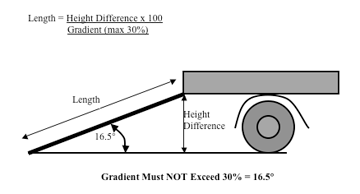
Should I allow extra capacity in the ramps for safety?
No. Our ramps are manufacturer and engineered to European TUV standards, which require us to build in a 200% safety. When calculating which capacity you require you must factor in the weight of the machine, the load if any, the operator, fuel/oil and attachments. Please note if you exceed the stated capacity the warranty is invalidated.
How durable are aluminium ramps compared to steel?
If the ramps are used sensibly, there is no reason why aluminium ramps should not last as long as steel, and much longer than steel ramps with wooden inserts.
Do the ramps have a minimum load height?
Yes, please check specs of each ramp.
What is the benefit of the rubber container ramp?
The Rubber Container Ramp has a capacity of 10,000kg and is provided in modular pieces to allow this to easily put in place and removed by one person.
Why do these need to be used at a specific load height?
The foot of the ramp is cut for the specific load height, when used at the incorrect load height the weight will not be able to take the required weight and the warranty will be void.
What is the benefit of a Wedge Ramp?
These can be customised to match your required height. They are perfect for loading pallet trucks to heights up to 120mm and can hold capacities up to 2920kg.
Can the Aluminium Container Ramps be customised?
Yes, our aluminium ramps can be customised in terms of width, length, connection and capacity to meet your requirements.
Can you use all kind of pallet trucks or forklifts on the container ramps?
No. Most pallet trucks and forklifts are not built to be used on slopes or at an incline. Therefore you can use only the smoothest gradient. Please check the manual of the manufacturer for the gradient information.
Wheelchair Bridge Ramp FAQs
Are they suitable for electric wheelchairs & mobility scooters?
We do not recommend bridge ramps for electric wheelchairs or mobility scooters as they tend to have very low ground clearance & a long wheelbase which means as they cross the underside catches & they can become stuck on the ramp. If you have a mobility scooter or electric wheelchair we would recommend a rubber threshold ramp on either side of the door or our rollAble ramps which can lay over the top of the threshold to create a bridge ramp.
How wide are they?
Most of our bridge ramps are about 70cm wide so that they are narrow enough to fit in door frames but still wide enough for a manual wheelchair.
Can they be used on uneven rises?
We recommend bridge ramps for even heights otherwise one ramp will be steeper than the other which is not comfortable to cross & could cause the ramp to move during use. For this situation you can use either the adjustable threshold ramp with entry plate or drive in ramp. Alternatively you can place a rubber threshold ramp on either side of the doorway.
How can I ensure the ramp does not come into contact with the threshold?
The adjustable threshold ramp with entry plate and bridge threshold ramp up to 75mm has legs/supports to prevent the ramp and preventing it touching the threshold. Other bridge ramps do flex and may come into contact with the threshold, we would recommend checking your doorway is suitable prior to use.
Can I leave the ramp in place?
As the ramp is placed in the doorway, you will be unable to close the door while the ramp is in place. Our folding drive in ramps can be left in place as it has a fold-up tail which can be moved to allow the door to close.
How can I purchase the rubber threshold ramp VAT exempt?
Yes, all of our wheelchair ramps can be purchased VAT exempt. VAT exemption is available if you are disabled or you are purchasing on behalf of someone on is disabled, for example a friend or family member. Charities can also purchase VAT exempt. At the checkout stage there is a VAT exemption box, we simply require the name of the person the ramp is for and disability. If this is for a charity, please provide the charity name and charity number.
Folding Wheelchair Ramps FAQs
How wide is a wheelchair ramp?
Wheelchair Ramps are provided in various widths, our standard folding wheelchair ramp is 720mm wide. The key is to check the width of your doorway to ensure the ramp will fit in the required door. In addition the width of the wheelchair needs to be checked to ensure the wheelchair will fit on the chosen ramp.
Can I rent a wheelchair ramp?
No, we do not rent wheelchair ramps. By selling new ramps only, we are able to offer at least a 1 year warranty. This can only be provided on new ramps as we can ensure they are provided to you in perfect condition.
What is a portable wheelchair ramp?
Portable wheelchair ramps are designed to be used on a temporary basis. They are often folding or telescopic for ease of storage and transport. These ramps can be great for those who wish to travel or use the ramps on a variety of steps/thresholds.
How long does a wheelchair ramp need to be and what is the maximum slope of a ramp?
We recommend a minimum of a 1:6 gradient for manual wheelchair, 1:8 gradient for electric wheelchairs and scooters. A 1:12 gradient is recommended for modular ramp systems.
Are portable wheelchairs safe?
As long as portable ramps are used within the capacity stated for the ramp, for their recommended purpose (loading wheelchairs) and within the recommended load height they are safe to use.
What is a suitcase ramp?
A suitcase ramp is a folding portable wheelchair ramp which folds up as if it were a suitcase to allow the user to easily carry the ramp and use in alternative locations.
Are wheelchair ramps suitable for manual and electric wheelchairs?
Our standard folding ramps and our rubber threshold ramps are suitable for manual wheelchairs, electric wheelchairs and scooters. Channel ramps are only suitable for manual wheelchairs. If you are unsure please check the symbols on the product page which state which types of wheelchairs they are suitable for you, alternatively simply ask one of our advisers
How much does an aluminium ramp cost?
Our aluminium wheelchair ramps come in a variety of ranges, some of which are cheaper than others. You can view our economy range here for some of the cheaper options.
Do I qualify for VAT exemption?
Wheelchair Ramps can be purchased VAT exempt if you have a long term disabilty. Simply enter your full name (or the name of the person the ramp is for) and disability in the checkout box. If you are a charity, simply enter the charity name and number.
Speed Bump FAQs
What is the purpose of speed bumps?
Speed Bumps are designed to slow down vehicles and increase safety within pedestrian zones.
What is the legal height of speed bumps?
The recommend height varies depending on your location (country) and the type of road, the minimum height is 25mm, they must be no more than 100mm high.
What regulations are in place regarding speed bumps?
The Highways (Road Humps) Regulations 1996 outline rules around road humps and traffic signs.
Do speed bumps work?
Speed bumps have been proven to reduce speed in many locations, and make neighbourhoods safety.
Do speed bumps damage cars?
Cars and vehicles with low ground clearance need to be especially careful when going over speed bumps. As long as the driver is driving at the recommended speed the car should not be damaged by the speed bump.
How much is a speed bump?
You can view our current prices on the speed bump product pages. Prices includes fixings and a free drill bit.
Does The Ramp People install speed bumps?
We do not install speed bumps however we do provide fixings for tarmac and concrete within the price, along with a free drill bit. The speed bumps can easily be installed by a handyman or builder, our speed bump installation guide can be viewed here.
Do you need planning permission for speed bumps?
You will need to check with the land owner, or local council, prior to installing speed bumps as you will be drilling the fixings into their land.
What length of speed bump do I need?
This does depend on the road you are installing these on. You will need to measure the width of the road. We recommend leaving some space between the speed bump and pavement to allow pedestrians and cyclists to pass safely. Some opt to have one long speed bump across the road whilst others have 2 speed bumps, one on each side of the road and a gap in the middle, it is personal preference.
What capacity do the speed bumps take?
Our heavy duty speed bumps have a capacity of 60,000kg and therefore are recommended for areas with trucks, lorries and vans passing through. If you are installing speed bumps in an area where only cars pass through, our 50mm and 75mm speed bumps will be suitable as these have a 20,000kg capacity.
What are speed cushions?
Speed cushions are larger than speed bumps in general and are more suitable for larger vehicles, our speed cushions can be viewed here.
Are speed bumps safe?
Speed bumps increase safety but you should take measures to ensure the road user is aware of the speed bumps to prevent any damage to the cars. For example, clear signage is required so road users are aware that the road has speed bumps. Reflectors and chevrons on the speed bump help ensure the user is able to see them.
What are flow plates?
Flow plates help to manage the flow of traffic and increase road safety. They come in various styles, for example including spikes to ensure traffic can only travel one way, they are often used within industrial estates and car parks to improve safety and security.
Modular Ramp FAQs
What is a modular ramp?
Modular wheelchair ramps are ramp systems which are provided in various pieces which connect together to create the required ramp length. These ramps can be provided with or without handrails. They can be created in any length for a variety of heights. Generally the recommended gradient for a modular ramp is 1:12.
What size door is required for wheelchair access?
It does depend on the size of the wheelchair. Our modular kits are provided in various widths between 900mm -1500mm whilst our portable ramps are provided in sizes from 660mm upwards.
Can modular ramps be customised?
Yes. The ramps can be provided in any length. The ramps can include platform(s) as required along with step kits and U-shaped handrails to meet the users needs. Our team will be happy to assist in providing a quote based on your requirements.
How easy is it to assemble a modular kit?
A confident DIYer or builder will be able to put together our modular kits. We have an instruction video and guide available here.
What measurements do I need to work out which kit I require?
A simple guide to working out what measurements you need can be found here.
What is the modular ramps made from?
Our modular wheelchair ramps are produced from anodised aluminium or galvanised steel. This ensures the ramps do not rust.
Are wheelchair ramps required?
In private homes it is up to the individual as to whether they have wheelchair ramp access. The Disability Discrimination Act (1195) states businesses must make reasonable adaptions to provide access to disabled users.
Do the ramps comply with Part M and Part K building regulations?
Our modular ramp kits are designed as portable, temporary solutions and therefore do not need to comply. If you do require a compliant system please let us know so we can provide a specification for you.
How long does it take to put the modular kit together?
It does depend on the persons abilities who is putting the ramp together and the length/size of the system purchased. Please view our modular video and instruction guide for a better understanding of how the systems are put together to allow you to estimate how long it may take you.
I want a ramp which I can leave in place but I do not want a modular system, is there a solution?
Yes. We have a portable wheelchair ramp with handrails (handrails are optional) which can be secured into place as there is a predrilled hole in the ramp. They can also be used as portable ramps by simply resting these on the step. They are available in 6ft - 10ft and are suitable for manual wheelchairs, electric wheelchairs and scooters.
I require steps and a ramp, is this possible?
Yes, we have various step kit available, for further advice please contact our team so they can work with you to find the best solution based on your requirements.
Do I qualify for VAT exemption?
Wheelchair ramps can be purchased VAT exempt if you have a long term disabilty. Simply enter your full name (or the name of the person the ramp is for) and disability in the checkout box. If you are a charity, simply enter the charity name and number. Please note, companies do not qualify for VAT exemption however we will of course provide a full VAT invoice after purchase.
Wheelchair Ramp Accessories FAQs
What are portable platforms for wheelchair ramps?
Our portable platforms can be used in conjunction with most of our ramps to create an 'L' shape ramp layout. They are ideal in situations where someone, for example requires a 10ft ramp but does not have the space for a 10ft ramp, for example due to a road or wall. Instead, the platform allows you to have, for example a 5ft ramp go from the door to the platform. The user can then use the platform as a turning space. The wheelchair user would then have a further ramp to go from the platform to ground level. Our portable platforms can be seen here.
What are wheelchair joining supports used for?
Joining supports are used to connect 2 wheelchair ramps together to create one long ramp. Many find them beneficial as it reduces the weight of the ramp, for example instead of having one 8ft ramp they purchase 2 x 4ft ramps and a joining support. The joining support can be adjusted to your required height.
Which ramps can have handrails?
The wheelchair ramps with handrails can be purchased with or without handrails. Our modular wheelchair ramp systems are normally provided with handrails.
Which ramp can be used to load my scooter/electric wheelchair into the car?
We have specific ramps designed for loading empty scooters and electric wheelchairs into the car. They are lightweight and folding for ease of storage. They are suitable to be used in vehicles with heights up to 660mm. The ramps are channel ramps however they only have an edge on one side and therefore clearence is not a problem Our scooter and electric wheelchair loading ramps can be found here.
Why are specific cable protectors required for wheelchair users?
Our cable protectors for wheelchair ramp access are built to a suitable gradient for wheelchair users, they can be viewed here. Many wheelchairs, especially electric wheelchairs have low ground clearence and therefore struggle to overcome some cable covers. Many therefore opt to purchase our wheelchair friendly cable protectors for areas where pedestrians and wheelchair users as likely to need to pass these.
Can wheelchair ramps include steps?
Our modular wheelchair ramps can be provided with step kits to allow users to choose to either walk up the steps or walk up the ramp. The step kits are produced from galvanized steel and have rubber coated guides, they can be provided with or without handrails.
What if I require a longer wheelchair ramp at a later date, do I need to buy a full new ramp?
The RollAble ramp can be built to any length so, if you opt to purchase a roll up ramp you can buy additional lengths at a later date to simply clip onto the exsisting ramp to create your new desired length. In the same way you can also remove part of the ramp to reduce the length of the ramp.
Mobile Yard ramps FAQs
What is a mobile yard ramp?
A mobile yard ramp is used to load and unload shipping containers without the use of a permanent docking bay. The ramp is placed and the back of the vehicle, allowing machines such as forklifts and plant machinery to gain access into the container to unload and load containers quickly and safely.
What is the capacity of a yard ramp?
We provide yard ramps with capacities up to 15,000kg, if you require a higher capacity please let us know as these can be customised to your specifications.
Are the mobile yard ramps customisable?
Yes, the ramp can be customised in terms of length and width. The ramp can also be produced with handrails for increased safety.
Are the ramps certified?
Yes, our yard ramps are CE marked and produced in Europe.
How easy is it to put the mobile yard ramp into place?
The mobile docking yard ramp can easily be moved as it has a fixed swivel clamp which allows a forklift to easily move the ramp into place. The ramp is provided on rubber tyres which helps allow it to turn with ease. The height of the ramp can easily be adjusted using the hydraulic pump. The ramp is deliveried ready to use, simply unload the yard ramp off of the trailer using a forklift and start using your yard ramp!
What are the mobile yards made from?
The ramps are produced from steel, they have a mesh anti-slip surface to ensure optimal grip and safety. The ramps are suitable to be used in all weathers.
Are the ramps safe to use?
Yes the ramps are CE marked. The ramp is produced with a mesh surface to provide extra grip, the ramps are customisable and can include handrails to increase safety further if required. Steel safety chains are also provided, which include large hooks, to allow the ramp to be secured in place during use. The ramps are provided with a full user manual along with a 1 year warranty.
How long does it take to get a yard ramp?
The lead time on the yard ramps depends on availability. Our stock is live so some days we have these available for immediate dispatch whilst, in other instances the lead time is a 2-4 weeks. Please contact our team for an accurate lead time.
Can the ramp be used on a slope?
That depends on the slope. If you are planning to use the ramp on uneven ground, please contact us before ordering.
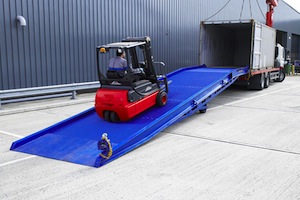
Road Safety & Traffic Calming FAQs
Speed Bump Signs
Do you need speed bump warning signs?
The Highways (Road Humps) Regulations 1996 state you must provide the appropriate warning signs as per the Traffic Signs Regulations on roads where there are speed bumps to ensure safety of road users is maintained. We provide a range of CE-marked and compliant speed bump signs which confirm to European standards and meet the requirements of BS EN 12899-1:2007 Class RA1. The speed bump signs can be wall or post mounted depending on your requirements. They are provided in high colour contracts to ensure visibility.
Wheel Stops & Parking Blocks
What is a car stop?
Car stops/wheel stops are used to reduce vehicle damage within areas such as car parks, driveways and industrial units. The parking blocks guide the driver into the space and alert them when they are near to a wall/fence. The wheelstops are secured into place using fixings, we provide fixings which are suitable for tarmac and concrete. They are provided in a variety of colours to increase visibility and to prevent them being seen as a trip hazard.
How wide is a parking block?
We have a variety of parking blocks available varying in sizes from 550mm - 20000mm.
Trench Covers & Road Plates
What are trench covers and road plates?
Trench covers and road plates are used to cover holes in the pavement or road to increase safety. They are often used when building works are occurring. They provide a safe route for pedestrians and vehicles to pass over. Our trench covers and road plates are provided in yellow to ensure high visibility.
Kerb Ramps
What height kerb ramp do I need?
We recommend measuring your kerb to identify the required height as kerb heights can vary. We have a variety of kerb ramps available from 70mm upwards, they are provided in plastic and rubber with capacities up to 15,000kg.
How do I secure a kerb ramp to the ground?
We provided fixings for concrete and tarmac with our kerb ramps to allow you to secure these in place.
Can I drop my own kerb legally?
You will need to secure planning permission to legally drop your own kerb and therefore our kerb ramps are a great solution if you wish to overcome a kerb as they are portable, temporary solutions which can be simply put in place when required. The cost of a kerb ramp is also much cheaper than the cost to drop a kerb.
Traffic Cones
How much is a traffic cone?
The prices vary. You can view our traffic cones prices on the product pages.
What rules affect traffic cones?
Chapter 8 Traffic Management outlines the types of cones, colours and height of cone required to be used in various situations. There are also rules in relation to the distance apart of the cones and the pattern they should be placed in. The regulations were created by the Department for Transport.
What do the colour of cones mean?
Orange cones are the most commonly used cones within the UK and are commonly used to block off areas of the road, highlight roadworks and hazards. Green cones represent the opening to access lanes. Blue cones make drivers, especially lorries, aware of overhead structures, such as cables or bridges. Yellow cones highlight no stopping zones.
What are traffic cones used for?
Traffic cones have various uses. The main purpose is to act a temporary structure to either warn drivers of risk or instruct them of an alternative route they should be taken.
Are traffic cones heavy?
Traffic cones vary in weight depending on there height, from 6kg - 7.5kg.
Why are traffic cones different heights?
The height of the cone required depends on the speed traffic travel at on the road, for example, in 60mph roads the cone must be 750mm high or more.
Barriers
What is a Chapter 8 barriers?
Chapter 8 Barriers refer to pedestrian barriers which are compliant with Chatper 8 Traffic Management, as set out by the Department for Transport.
What is the purpose of a barrier?
A blow moulded safety barrier prevents pedestrians walking into dangerous areas and therefore in turn reduces risk.
Wheel Chocks FAQs
Are wheel chocks required?
Wheel chocks are not required in the majority of instances however they can improve safety and reduce the risk of damage to surrounding areas as they prevent accidental movements of vehicles.
What is the purpose of wheel chocks?
Wheel chocks are used to prevent vehicles, including lorries and planes, rolling accidentally. Wheel chocks are used as an additional safety device, along with the vehicle break. They are often used when a vehicle is parked on a hill, or during loading/unloading.
How many wheel chocks do you need?
A minimum of 2 wheel chocks is required for the wheel chocks to work effectively. For wet or muddy ground conditions, several chocks may be required.
Where should wheel chocks be placed?
Wheel chocks must be placed downhill. For example, when a car is facing downhill, the chocks would be placed in front of the front wheels. When the car is facing uphill, the chocks should be behind the rear wheel.
How do chocks work?
Wheel chocks work by preventing the car from rolling. It is important to ensure tyres are properly inflated to prevent failures occuring.
Are wheel chocks safe to use?
Health and safety assessments should be undertaken prior to using wheel chocks. Due to the location wheel chocks are placed in, individuals can be put at risk when moving the wheel chocks and therefore drivers need to be aware not to move until they have been informed it is safe to do so.
Which wheel chock should I buy?
You need to consider the size of the vehicle, weight of the vehicle and the ground type when buying a wheel chock. Smaller tyres require smaller chocks. We have a range of wheel chocks suitable for cars and industrial machinery which can be viewed here. In addition we have aviation wheel chocks which are suitable for various aircraft sizes.
What are wheel chocks made from?
We have a variety of wheel chock which are produced from various materials including rubber, plastic and polyurethane.


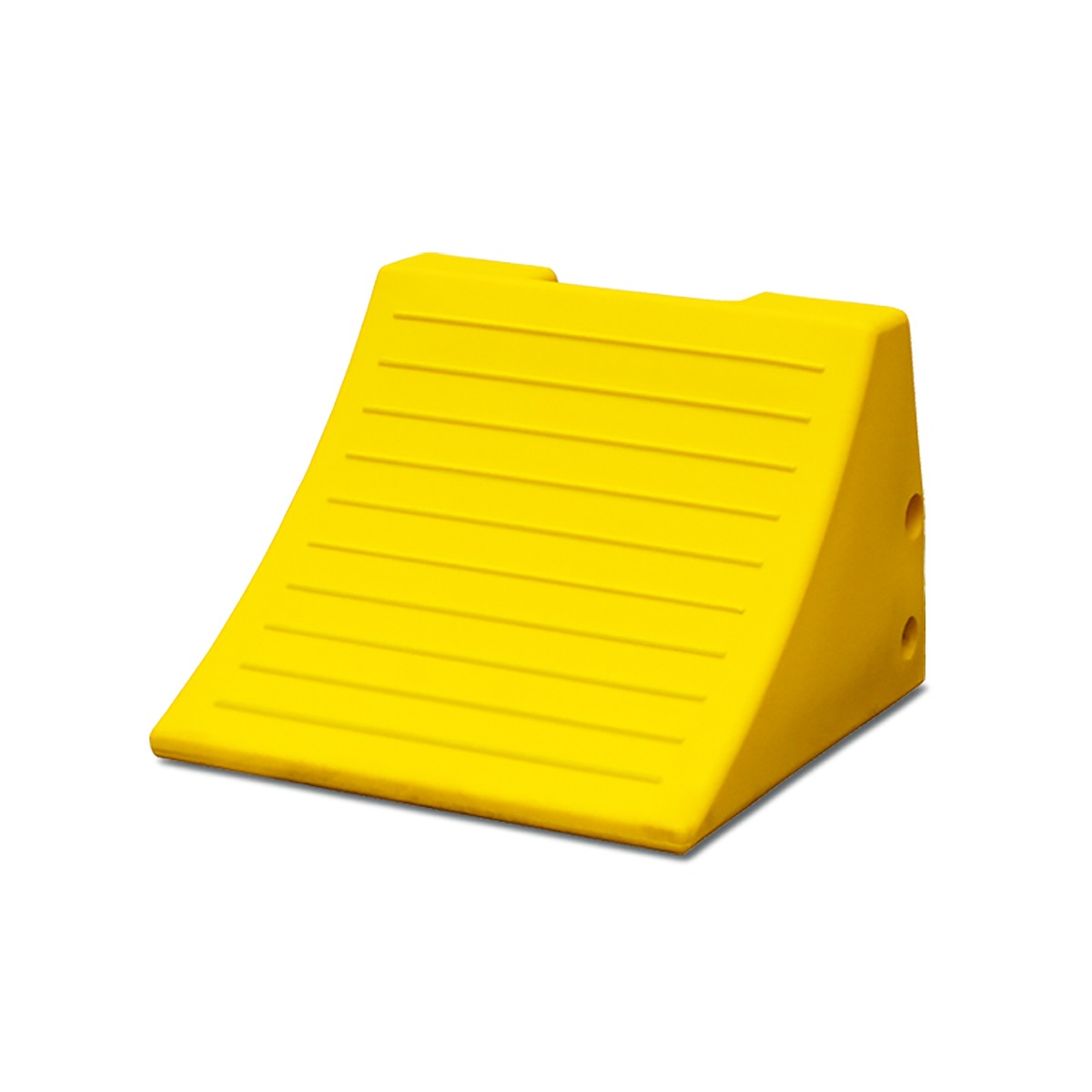
Warehouse Protection FAQs
Column Protector
Column protectors are designed to prevent damage to columns during collisions, for example with forklifts, and improve the safety of the driver. They are provided in various sizes to fit various different sized columns. They are produced with an air vent system to allow air to escape during impact. The protectors are provided in yellow to ensure high visability.
Beam Bumper & Channel Rack Protectors
Beam bumpers and channel rack protectors are designed to protect the warehouse racks from pallet and forklift damage. Like column protectors, they are easy to install and are provided in yellow to increase visability. The blow moulded design allows them to easily absorb impact. You can view the full range here.
Dock Bumper
Dock bumpers offer additional protection within loading docks, warehouses, parking garages and marinas. The dock bumpers are designed to be attached to the dock and absorb impact when hit by, for example a truck reversing into the dock. They are produced from rubber and provided with predrilled holes for easy installation.
Ground Protection Mats FAQs
What are ground protection mats?
Ground protection mats are used to protect the land from damage caused by pedestrian and vehicle traffic. They are generally used on a temporary basis during construction works and festivals to protect the ground.
What do I need to consider when buying a mat?
When buying ground protection mats you need to consider: size of area you wish to cover, capacity of the mat (e.g. is it for pedestrians, vehicle traffic or plant machinery) and ground type the mat will be placed on. In addition, you will need to consider the health & safety, for example some mats are provided with ramped edges to ensure they are wheelchair friendly whilst others are designed to be suitable to be used with steel tracked machinery. For advice on which mats meet your requirements, please contact our team.
How do the mats connect together?
Different connection options are provided with different mats. Connection types include; cable ties, bolts & washers, interlocking tongue and groove system.
What weight can a ground protection mat hold?
All mats are rated to different capacities depending on the purpose of the mat. Some are designed for pedestrian traffic whilst others have a capacity of over 60,000kg as they are designed to hold tracked machinery. Please note, the capacity of the mat is affected by the ground conditions.
What is the benefit of using ground protection mats?
Ground protection mats are beneficial in protecting the land from damage during heavy pedestrian traffic & vehicle traffic. In addition, the mats can allow construction machinery to easily gain access to areas which may be especially muddy or sensitive areas, for example heritage sites. The non-slip surface on some mats prevents vehicles and pedestrians slipping in boggy areas, therefore reducing health and safety risks. The mats are reusable and therefore can be used at various different sites again and again to ensure they are economically beneficial.
How easy is it to install ground protection mats?
The mats vary in weight so please check this prior to purchase. Generally one mat can be lifted by 2 people and therefore they are normally quite easy to install.

Anti-Fatigue Mats FAQs
What are anti fatigue mats?
Anti-fatigue mats are designed to reduce fatigue that is caused by standing for long periods of time on a hard surface.
What are they made of?
They can be made from a number of materials; our range are mainly made of rubber or PVC with a backing of microcellular vinyl.
How do they work?
Made with innovative ergonomic materials, anti-fatigue flooring encourages natural movement and adjustment of the feet to stimulate the contraction and expansion of muscles in the legs, hips and lower back. They also have slip resistance to reduce slips and falls in the workplace.
How long will they last?
How long the mats last would depend on how much traffic is going over them on a daily basis, most of our anti-fatigue mats come with a minimum 2-year warranty, but their service life depends on environment & application.
Are they required by law?
Currently in the UK, there is no legal obligation for employers to provide anti-fatigue mats for their employees.
Are they worth it?
Anti-fatigue matting can help prevent slips, trips, falls, heel strike, back pain and muscle aches, reducing the amount of injury in the workplace reduces absences and can increase productivity.
Do I need different mats for different areas?
This is dependent on what each area is used for, for example, you would need different mats for wet and dry areas, or if oil is being used in an area.
Are they cost effective?
The costs linked with absences and accidents to businesses across the world reach far into the billions. Anti-fatigue mats can reduce the effects of standing fatigue and can reduce the number of slips and trips, saving money on sickness and absence.
What do I need to consider when purchasing anti-fatigue matting?
You will need to consider what properties you need the mats to have, you can do this using our anti-fatigue mat finder.
How thick should an anti-fatigue mat be?
They are usually between ¼” to ¾” thick, the thickness will depend on the mat that is most suitable for your needs.
How do you clean anti-fatigue mats?
Dependant on the mat purchased, you can either jet wash or sweep them, however you would need to refer to the manufacturer guidelines.
How often should you replace them?
How often you need to replace the mats depends on the environment, application and number of shifts.
What does wear resistance, slip resistance and anti-fatigue mean?
The wear resistance indicates the time it takes for a mat to lose its functionality, the slip resistance refers to the slip resistance of the mat and anti-fatigue is the degree of comfort that the mats will provide to the users.
Roll Up Ramp FAQs
How wide is a wheelchair ramp?
Our RollAble wheelchair ramps are provided in various widths from 660mm up to 1200mm. The key is to check the width of your doorway to ensure the ramp will fit in the required door. In addition, the width of the wheelchair needs to be checked to ensure the wheelchair will fit on the ramp.
Can I rent a roll up wheelchair ramp?
No, we do not rent wheelchair ramps. By selling new ramps only, we are able to offer at least a 1 year warranty. We can only provide this on new ramps as we can ensure they are supplied in perfect condition. What is a portable wheelchair ramp? Portable wheelchair ramps are designed to be used temporarily rather than a fixed structure. They are often folding, roll up or telescopic for ease of storage and transport. These ramps are ideal for people who travel or use the ramps on a variety of steps/thresholds.
How long should a wheelchair ramp be?
We recommend a minimum of a 1:6 gradient for manual wheelchair, or 1:8 gradient for electric wheelchairs and scooters. Since electric wheelchairs and scooters have a low ground clearance, they require a smoother gradient. A 1:12 gradient is recommended for modular ramp systems so more space is needed. You can use our ramp calculator to help you work out what ramp length you required.
We also recommend our roll up ramps are puchased 1ft longer than normal due to their large rest on connection.
Are portable, roll up wheelchairs ramps safe?
As long as portable ramps are used within the stated capacity, used for their recommended purpose (as mobility aids) and within the recommended load height they are safe to use.
What is a roll up ramp?
A roll up ramp is a portable wheelchair ramp which rolls up when not in use. This means it’s easily stored and the user can easily transport the ramp and use it in various locations.
Are wheelchair ramps suitable for manual and electric wheelchairs?
Our RollAble ramps are suitable for manual wheelchairs, electric wheelchairs and scooters as long as they are used at the correct gradients. If you are unsure please check the symbols on the product page which state which types of wheelchairs they are suitable for you, alternatively simply ask one of our advisers.
How much does a roll up ramp cost?
Our aluminium roll up wheelchair ramps come in a variety of options, some of which are cheaper than others.
Do wheelchair ramps need handrails?
Handrails are not required for portable and temporary wheelchair ramps, however, if you are looking to leave the ramp in place then they can be a great addition. Our roll up ramps can be purchased with or without handrails.
Do I qualify for VAT exemption?
All mobility aids and wheelchair ramps can be purchased VAT exempt if you have a long term disability. Simply enter the full name of the user and their disability in the checkout box. If you are a charity, simply enter the charity name and number.
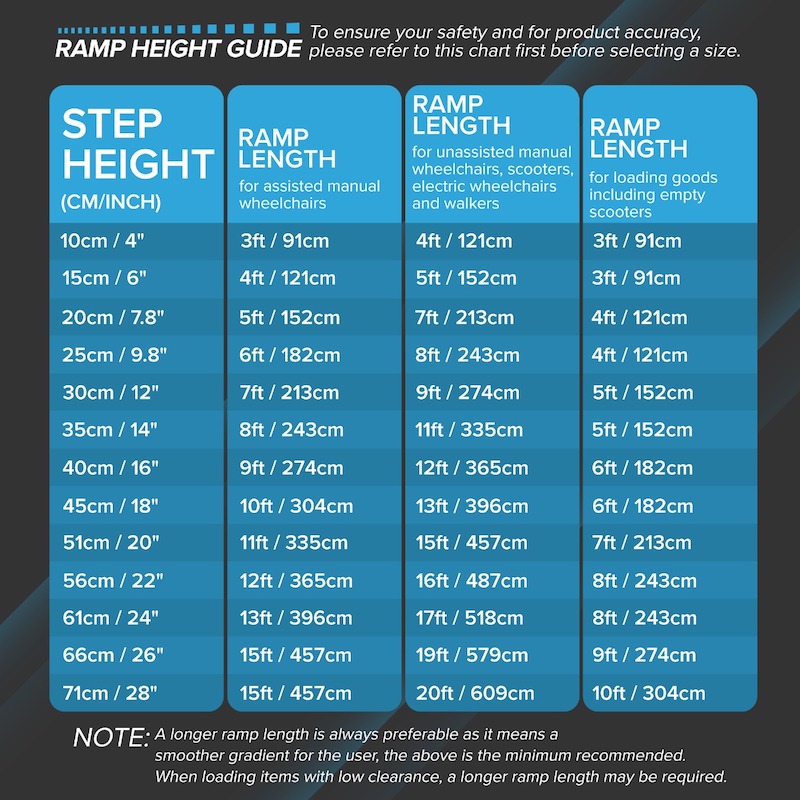
Dog Ramp FAQs
What angle should a dog ramp be?
We recommend our dog ramps and pet ramps are used at a maximum gradient of 1:3.3 to ensure they are not too steep. For example, for a height of 450mm we would recommend a ramp length of 1500mm. However, you will need to consider your pets abilities and whether they would need less of an incline if they have mobility issues.
Are steps or ramps better for dogs?
You should consider your dog's abilities and mobility issues when considering whether to get steps or ramps for your pet. Smaller dogs or dogs with mobility issues may struggle to climb steps or stairs especially if they are high so a ramp may be a better option. However, if you have a larger dog without mobility issues, our pet steps may be easier to store and transport and store.
Are dog ramps worth purchasing?
Here at The Ramp People, we definitely believe dog ramps are worth purchasing for your furry friend! Any pet or dog that is struggling to get up an obstacle will find it much easier if allowed to use a suitable dog ramp. If your pet has mobility issues, ramps will help to alleviate their pain when climbing up or down obstacles. Even pets without mobility issues can benefit, since regular jumping can put extra pressure on an animal's joints which could cause issues in the future.
Where can I buy a dog ramp?
We sell multiple pet ramps and steps in our dog ramp range on our website here. Please get in touch with our customer service team if you need assistance selecting something.
How do I secure the dog ramp safely?
At The Ramp People we specialise in portable, temporary ramps. So, like all of our other ramps, our pet and dog ramps simply rest in place when in use for easy and quick set-up. The weight of the ramp and the pet keeps the ramp firmly in place when in use.
Do the ramps have safety edges?
The majority of our dog ramps do have safety edges to help guide your dog and prevent them stepping off the ramp, however, we always suggest always supervising when your pet is using the products.


